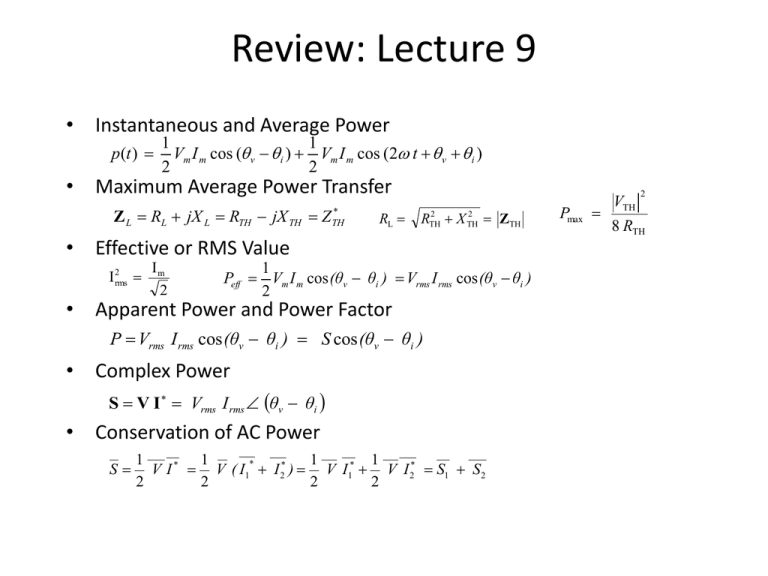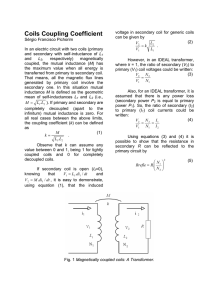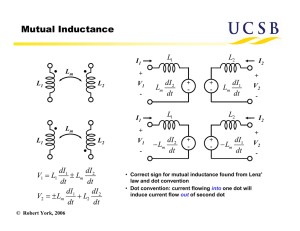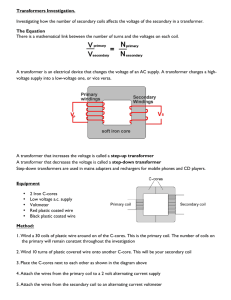Document
advertisement

Review: Lecture 9 • Instantaneous and Average Power p (t ) 1 1 Vm I m cos ( v i ) Vm I m cos (2 t v i ) 2 2 • Maximum Average Power Transfer * Z L RL jX L RTH jX TH ZTH RL 2 2 RTH X TH ZTH • Effective or RMS Value I 2rms Im 2 1 Peff Vm I m cos (θv θi ) Vrms I rms cos (θv θi ) 2 • Apparent Power and Power Factor P Vrms I rms cos (θv θi ) S cos (θv θi ) • Complex Power S V I Vrms I rms θv θi • Conservation of AC Power S 1 1 1 1 * V I * V ( I1 I 2* ) V I1* V I 2* S1 S2 2 2 2 2 Pmax VTH 2 8 RTH Review: Inductors Magnetic flux Faraday’s law Ampere’s law d dt N: turns Current i Three-dimensional magnetic field di dt d vN dt Oppose the change L Inductance: i vs. v d d di vN N dt di dt Len’s law Lecture 10 AC Circuits Magnetically Coupled Circuit Contents • • • • • • Mutual Inductance Energy in a Coupled Circuit What is a transformer? Linear Transformers Ideal Transformers Applications 4 Mutual Inductance Voltage induced v1 N1 11 Magnetic flux Links coil 1 only d1 dt 1 11 12 Magnetically coupled 12 Magnetic flux link both v2 N 2 M21 Express v2 in terms of the change of i1: v N d12 N d12 di1 2 2 2 dt di1 dt d12 dt Mutual inductance of coil 2 with respect to coil 1 Mutual Inductance • It is the ability of one inductor to induce a voltage across a neighboring inductor, measured in henrys (H). v2 M 21 di1 dt The open-circuit mutual voltage across coil 2 v1 M 12 di2 dt The open-circuit mutual voltage across coil 1 6 M12 and M21 ? The Upper Limit? • The coupling coefficient, k, is a measure of the magnetic coupling between two coils; 0≤ k ≤ 1. M k L1 L2 • The instantaneous energy stored in the circuit is given by 1 2 1 2 w L1i1 L2i2 MI1 I 2 2 2 7 Mutual Inductance: Dot convention • If a current enters the dotted terminal of one coil, the reference polarity of the mutual voltage in the second coil is positive at the dotted terminal of the second coil. Illustration of the dot convention. 8 Examples of the dot convention Dot convention for coils in series; the sign indicates the polarity of the mutual voltage; (a) series-aiding connection, (b) series-opposing connection. L L1 L2 2M (series - aiding connection ) L L1 L2 2M (series - opposing connection ) 9 Mutual Inductance: Time and Frequency domains KVL Time-domain analysis of a circuit containing coupled coils. i1 R1 L1 di1 di M 2 v1 0 dt dt i2 R2 L2 di2 di M 1 v2 0 dt dt Current leaves the dot Frequency-domain analysis of a circuit containing coupled coils Z1I 1 jL2 I 1 jMI 2 V 0 Z L I 2 jL2 I 2 jMI1 0 10 Mutual Inductance: Example Example 1 Calculate the phasor currents I1 and I2 in the circuit shown below. Ans: I1 13.01 49.39A; I 2 2.9114.04A 11 Energy in a Coupled Circuit: Example Example 2 Consider the circuit below. Determine the coupling coefficient. Calculate the energy stored in the coupled inductors at time t = 1s if v=60cos(4t +30°) V. Ans: k=0.56; w(1)=20.73J 12 What is a transformer? • It is an electrical device designed on the basis of the concept of magnetic coupling • It uses magnetically coupled coils to transfer energy from one circuit to another • It is the key circuit elements for stepping up or stepping down ac voltages or currents, impedance matching, isolation, etc. 13 Transformer • It is generally a four-terminal device comprising two (or more) magnetically coupled coils Linear: wound on a magnetically linear materials, air-core – radio/TV… Connected to the source Connected to the load V 2M 2 Zin R1 jL1 Z R , ZR is reflected impedance I1 R2 jL2 Z L 14 Linear Transformer: Example Example 3 In the circuit below, calculate the input impedance and current I1. Take Z1=60-j100Ω, Z2=30+j40Ω, and ZL=80+j60Ω. Ans: Zin 100.14 53.1; I1 0.5113.1A 15 Ideal Transformer • An ideal transformer is a unity-coupled, lossless transformer in which the primary and secondary coils have infinite self-inductances. V2 N 2 n V1 N1 Ideal Transformer (a) and Circuit symbol (b) I 2 N1 1 I1 N 2 n V2 > V1→ step-up transformer V2< V1→ step-down transformer 16 Ideal Transformer: Example Example 4 An ideal transformer is rated at 2400/120V, 9.6 kVA, and has 50 turns on the secondary side. Calculate: (a) the turns ratio, (b) the number of turns on the primary side, and (c) the current ratings for the primary and secondary windings. Ans: (a) (b) (c) This is a step-down transformer, n=0.05 N1 = 1000 turns I1 = 4A and I2 = 80A 17 Applications: Isolation device • Transformer as an Isolation Device to isolate ac supply from a rectifier 18 Applications: Matching device • Transformer as a Matching Device Using an ideal transformer to match the speaker to the amplifier Equivalent circuit 19 Applications: Example Example 5 Calculate the turns ratio of an ideal transformer required to match a 100Ω load to a source with internal impedance of 2.5kΩ. Find the load voltage when the source voltage is 30V. Ans: n = 0.2; VL = 3V 20 Lecture 11 AC Circuits Frequency Response Appendix Applications: Power distribution • A typical power distribution system 23





